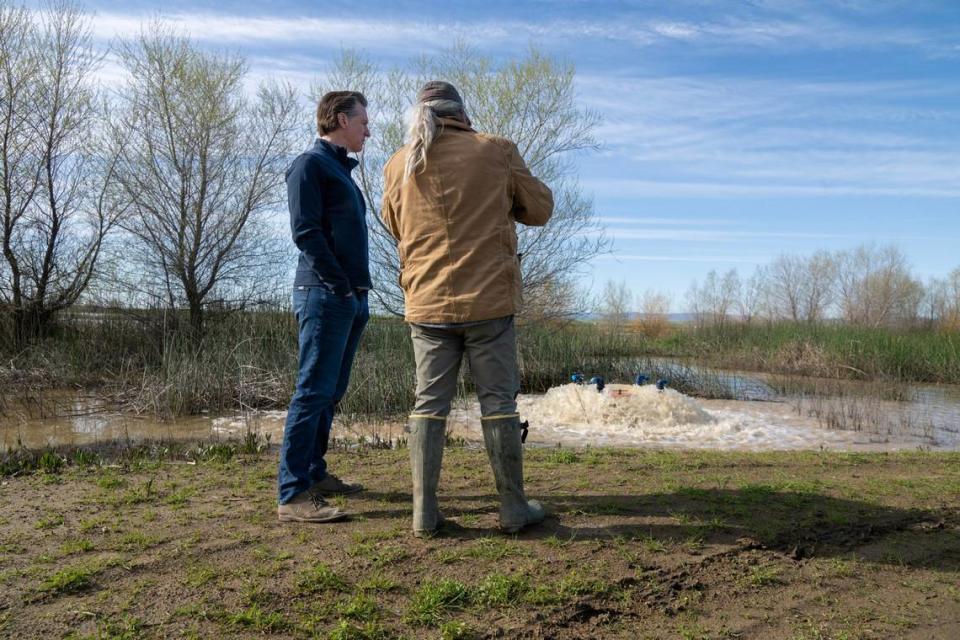Gavin Newsom lifts California drought restrictions after record-breaking winter storms
Gov. Gavin Newsom rescinded many emergency drought measures Friday and officials said they will boost supplies for water agencies serving 27 million residents after a record wet winter significantly improved conditions left by three years of drought.
Newsom revoked requirements for local water agencies to enforce conservation measures and rolled back his own call for voluntary conservation. The Department of Water Resources also said it now expects to deliver 75% of requested water through the State Water Project, up from 35% announced last month.
Yet at a briefing beside flooded Yolo County wetlands, the governor stopped short of declaring the drought over and said some parts of his emergency order remain key to replenishing underground aquifers and preparing for future dry periods.
“It would be nice to have a governor say that the drought is over. But unfortunately, complication requires nuance,” said Newsom. “It’s incumbent upon us to continue to maintain our vigilance and maintain some provisions of the executive order to allow for fast tracking of groundwater replenishment projects, stormwater capture and recycling programs here in the state of California.”
Gavin Newsom says end to California drought isn’t cut and dry. Why experts are still worried
In an illustration of California’s climate extremes, a series of winter storms flooded Central Valley and coastal communities, filled up nearly empty reservoirs and cloaked the Sierra Nevada in record snowpack to reverse the state’s driest three years on record this winter.
Close to half of the state is classified as no longer experiencing drought, including the state’s major population centers in the San Francisco Bay Area and greater Los Angeles. Parts of the San Joaquin Valley meanwhile, are still experiencing flooding from this week’s storm.
In a new executive order, Newsom revoked most of his emergency drought proclamations of the last two years and rescinded a March 2022 order requiring urban water suppliers to enforce conservation measures such as limiting outdoor watering and penalize water wasters.
He also rescinded his July 2021 request that Californians voluntarily conserve water by 15%. Officials estimate that the appeal prompted residents to conserve some 600,000 acre-feet of water, enough to supply Sacramento for four years.
Wasteful water practices will still be banned by the Water Resources Control Board, such as using potable water to wash driveways, irrigating non-functional lawns and using hoses without automatic shutoff nozzles.
Of the governor’s 81 total emergency drought provisions, 32 will remain. According to the governor’s office, those include measures to streamline groundwater recharge and help provide drinking water for communities that rely on overdrafted aquifers.

Newsom said his patchwork approach to moving out of the drought reflect lessons learned after California’s last historic dry period of 2014-15 — that unique conditions across the state don’t lend themselves to blanket actions like statewide mandatory water cutbacks.
This wet winter, which included multiple atmospheric rivers that left dozens dead and caused severe property damage, enabled DWR to increase allocations on the State Water Project to 75%, said assistant deputy director John Yarbrough. The last time allocations reached 75% was in 2017.
The State Water Project is the complex system of reservoirs, canals and dams that serves as a major component of California’s water system, collecting from rivers in the state’s north and redistributing to urban areas in Southern California and the Bay Area. Around 30% is used for agriculture in the Central Valley.
Agencies with their own storage facilities can also expect extra water, primarily in Kern County and Southern California’s Metropolitan Water District. The agency is releasing water from Lake Oroville to make room for spring snowmelt, and expects to fill the San Luis reservoir for farm irrigation in the San Joaquin Valley.
“California continues to experience weather whiplash,” said DWR Director Karla Nemeth in a statement. “We’ve been able to manage the system to the benefit of communities, agriculture and the environment. It’s certainly been a welcome improvement following the three driest years on record for California.”
Despite improved conditions, officials urged Californians to continue conserving water. Communities with dry wells from depleted groundwater basins are still experiencing drought impacts, said Natural Resources Secretary Wade Crowfoot, and the Colorado River, a major water source for Southern California, remains in dire condition.
“We want to avoid this thought that it’s a ‘back to normal’ situation, because in a lot of places it just simply isn’t,” he said. “And also we need to move beyond this idea that we use water in a traditional way and then we move back. We want people to understand that everyone plays a role adjusting to these new extremes.”
Heather Cooley, director of research at the Pacific Institute, said this year’s extreme conditions give us a glimpse of what’s ahead. To prepare for future dry spells and flooding, Californians should be conserving and water managers should focus on resilience to those extremes.
“I’m not surprised that they’re lifting restrictions, but we don’t have water to waste in California any year. So restrictions may be diminished but we still need to make an effort to use water efficiently,” she said. “That will help our aquifers recover and help us prepare for the hotter, drier future we face.”
State Sen. John Laird, D-Santa Cruz, who served as Brown’s Secretary of Natural Resources, said he found Newsom’s rollback of emergency measures perfectly reasonable given the state’s wet conditions above ground, and dry ones below.
“No one understands a continued drought declaration after the 12th atmospheric river, but our groundwater reserves are still in a stressed position,” he said. “Everyone should be conserving over the long term as a way of life.”


